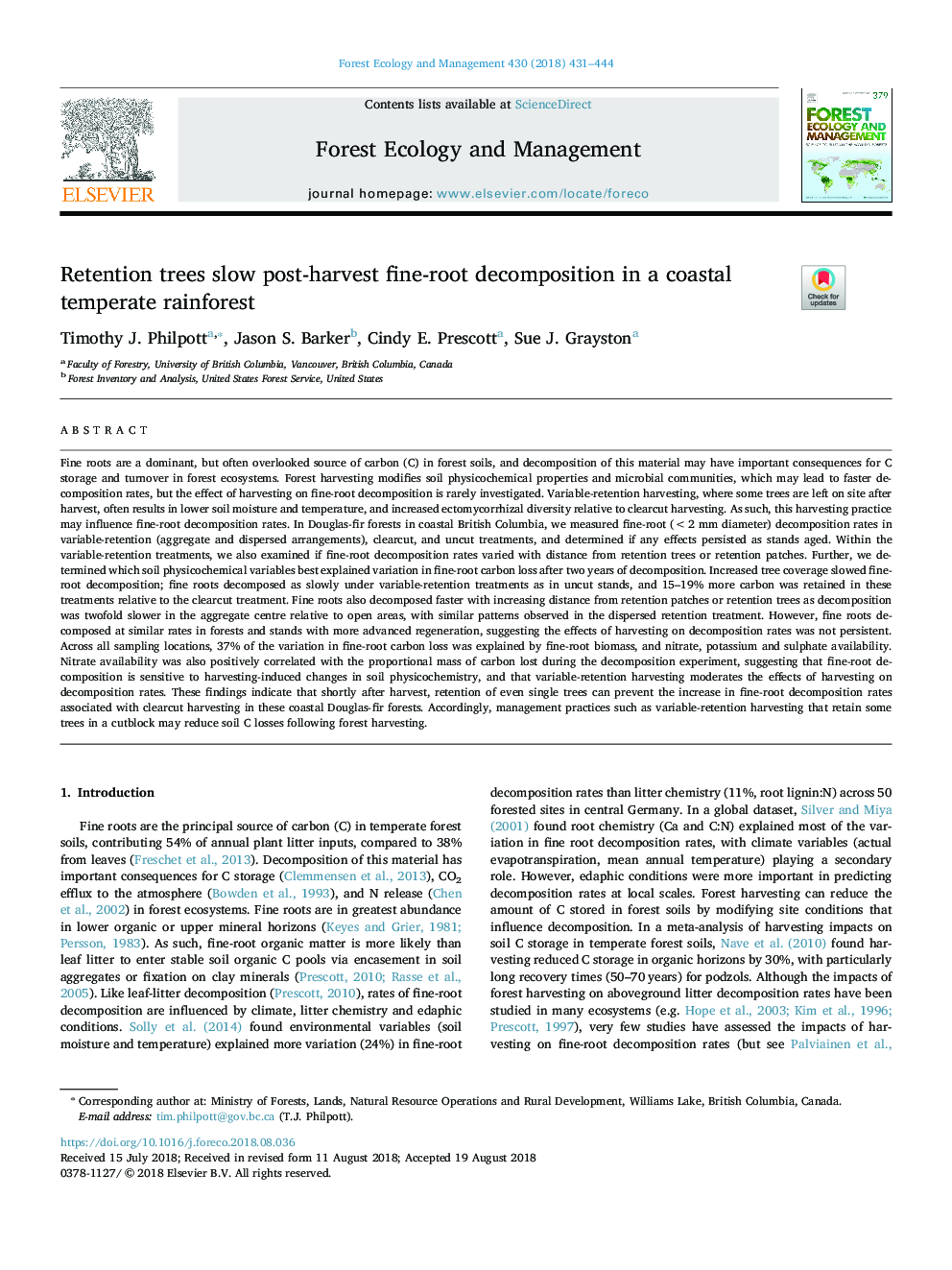| کد مقاله | کد نشریه | سال انتشار | مقاله انگلیسی | نسخه تمام متن |
|---|---|---|---|---|
| 11000038 | 1421330 | 2018 | 14 صفحه PDF | دانلود رایگان |
عنوان انگلیسی مقاله ISI
Retention trees slow post-harvest fine-root decomposition in a coastal temperate rainforest
ترجمه فارسی عنوان
درختان نگهداری، تجزیه ریشه دندانی پس از برداشت را در یک جنگل بارانی معتدل ساحلی کم می کند
دانلود مقاله + سفارش ترجمه
دانلود مقاله ISI انگلیسی
رایگان برای ایرانیان
موضوعات مرتبط
علوم زیستی و بیوفناوری
علوم کشاورزی و بیولوژیک
بوم شناسی، تکامل، رفتار و سامانه شناسی
چکیده انگلیسی
Fine roots are a dominant, but often overlooked source of carbon (C) in forest soils, and decomposition of this material may have important consequences for C storage and turnover in forest ecosystems. Forest harvesting modifies soil physicochemical properties and microbial communities, which may lead to faster decomposition rates, but the effect of harvesting on fine-root decomposition is rarely investigated. Variable-retention harvesting, where some trees are left on site after harvest, often results in lower soil moisture and temperature, and increased ectomycorrhizal diversity relative to clearcut harvesting. As such, this harvesting practice may influence fine-root decomposition rates. In Douglas-fir forests in coastal British Columbia, we measured fine-root (<2 mm diameter) decomposition rates in variable-retention (aggregate and dispersed arrangements), clearcut, and uncut treatments, and determined if any effects persisted as stands aged. Within the variable-retention treatments, we also examined if fine-root decomposition rates varied with distance from retention trees or retention patches. Further, we determined which soil physicochemical variables best explained variation in fine-root carbon loss after two years of decomposition. Increased tree coverage slowed fine-root decomposition; fine roots decomposed as slowly under variable-retention treatments as in uncut stands, and 15-19% more carbon was retained in these treatments relative to the clearcut treatment. Fine roots also decomposed faster with increasing distance from retention patches or retention trees as decomposition was twofold slower in the aggregate centre relative to open areas, with similar patterns observed in the dispersed retention treatment. However, fine roots decomposed at similar rates in forests and stands with more advanced regeneration, suggesting the effects of harvesting on decomposition rates was not persistent. Across all sampling locations, 37% of the variation in fine-root carbon loss was explained by fine-root biomass, and nitrate, potassium and sulphate availability. Nitrate availability was also positively correlated with the proportional mass of carbon lost during the decomposition experiment, suggesting that fine-root decomposition is sensitive to harvesting-induced changes in soil physicochemistry, and that variable-retention harvesting moderates the effects of harvesting on decomposition rates. These findings indicate that shortly after harvest, retention of even single trees can prevent the increase in fine-root decomposition rates associated with clearcut harvesting in these coastal Douglas-fir forests. Accordingly, management practices such as variable-retention harvesting that retain some trees in a cutblock may reduce soil C losses following forest harvesting.
ناشر
Database: Elsevier - ScienceDirect (ساینس دایرکت)
Journal: Forest Ecology and Management - Volume 430, 15 December 2018, Pages 431-444
Journal: Forest Ecology and Management - Volume 430, 15 December 2018, Pages 431-444
نویسندگان
Timothy J. Philpott, Jason S. Barker, Cindy E. Prescott, Sue J. Grayston,
